Naval Artists of the Age of Fighting Sail – Part 1
Philippe-Jacques de Loutherbourg
Some time ago I posted a short blog about the cutting-out of the French corvette Chevrette in 1801 (Click here to read it if you missed that blog). I had stumbled on this incident through finding in an 1894 publication a most dramatic engraving depicting it. It was based on a painting by somebody referred to simply as “de Loutherbourg”. Given that the name was an unusual one for an apparently British artist I decided to find out more. Not only did I discover a quite fascinating and unexpected story, but the quest introduced me to a number of other artists of the 18th and early 19th Centuries who specialised in maritime subjects. Several of these had stories – and backgrounds – as unusual as de Loutherbourg’s and I’ll return to them in later blogs. It is through the eyes of these men that we have come to form our mental pictures of the Age of Fighting Sail. It came as a surprise to me to learn that many of these painters, far from being studio-bound, had direct experience of life at sea, and even of combat, as I’ll tell of in future posts.
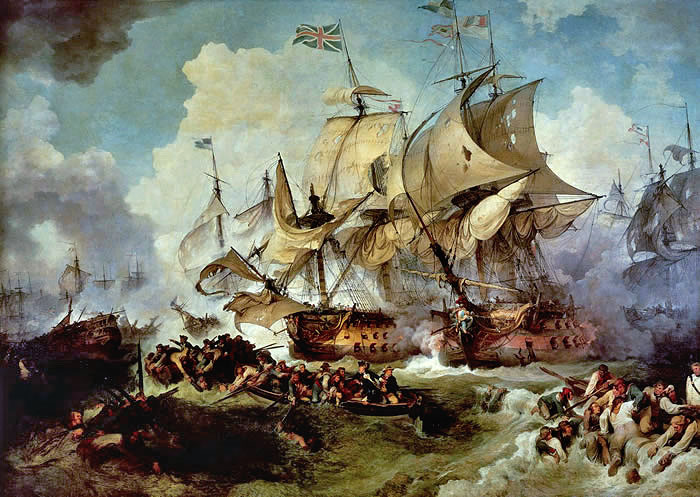
de Loutherbourg’s “The Glorious First of June”
Lord Howe’s victory 1794
It was during the 18th Century that Britain gained the global-power status which was to be confirmed during the Revolutionary and Napoleonic Wars. Through much of the period the performance of British land forces was patchy, and occasionally disastrous. Where at all possible Britain avoided land campaigns and instead used the wealth accruing from her maritime trade to subsidise European powers – such as Prussia – to do the fighting on her behalf. In establishing commercial as well as naval supremacy it was the Royal Navy which was to prove the decisive weapon, one unrivalled not only as regards power and size but as regards professionalism and bloody-minded dedication to victory. This fact was widely recognised throughout British society and, even if there was reluctance to provide adequate remuneration and acceptable terms of service, the Navy and its personnel were held in high esteem. Songs such as Rule Britannia (1740) and Heart of Oak (1760), both still loved and heard, bore witness to this. It was therefore no great surprise that painters specialising in naval subjects should find a ready market for their paintings with the more affluent, and for engravings of them for the less prosperous. It is in this context that de Loutherbourg and other artists like him should be seen.

de Loutherbourg in later life
Of Polish extraction, Philippe-Jacques de Loutherbourg was born in Strasbourg in 1740 and at the age of 15 was apprenticed in Paris to the eminent and fashionable artist Charles-André van Loo. His talent was quickly recognised and in 1767 he was elected to the French Academy, even though below the age normally set for this. His range of subjects was wide and already included sea storms and battles as well as landscapes. At an early stage however he was fascinated by the opportunities offered by stage productions and he experimented with a model theatre to produce effects such as running water, achieving this with clear sheets of metal and gauze.
de Loutherbourg’s increasing fascination with the theatre led him to accept an offer by David Garrick, the greatest actor of the day (who wrote Heart of Oak ) to move to London. Here, at the Drury Lane Theatre, de Loutherbourg designed scenery, costumes and, most significantly, stage effects of ever-greater sophistication. The latter depended heavily on coloured lantern-slides and lighting effects. de Loutherbourg was to spend the rest of his life in Britain, anglicising his name to Philip James. It is likely that, like many Frenchmen of his background, he would have found his country a most uncongenial place during and after the revolution.
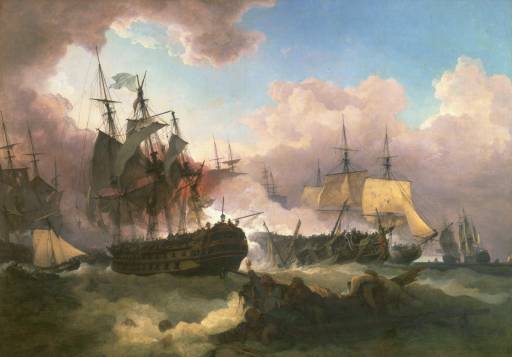
de Loutherbourg’s “The Battle of Camperdown 1797”
British victory over the Dutch fleet
In the midst of his theatre activities de Loutherbourg continued painting, encouraged by the friendship of Britain’s premier artist, Sir Joshua Reynolds. Though his range continued to be wide it was de Loutherbourg’s naval paintings which were to be most prestigious. Several were commissioned to commemorate great naval victories such as the Glorious First of June (1794) and are now in the National Maritime Museum in Greenwich. Not surprisingly, given his links to the theatre, these paintings are intensely dramatic. He made no attempt the fact that a degree of licence was taken for the sake of effect and in the prospectus for the engraving of his painting of the Battle of Camperdown (1797) it was frankly stated that:
“Mr. Loutherbourg has availed himself of the privilege allowed to painters, as well as epic and dramatic poets, of assembling in one point of view such incidents as were not very distant from each other in regard to time. These incidents have been associated as fully as the limits of the distinct picture would admit; and although many principal events, in which particular ships distinguished themselves, may not have been brought forward, yet the artist is satisfied that the officers of the navy will be indulgent for whatever it was not practicable to introduce; especially as it has been Mr. Loutherbourg’s plan to compose his pictures with an adherence to the principles of the art not usually consulted in marine painting.”
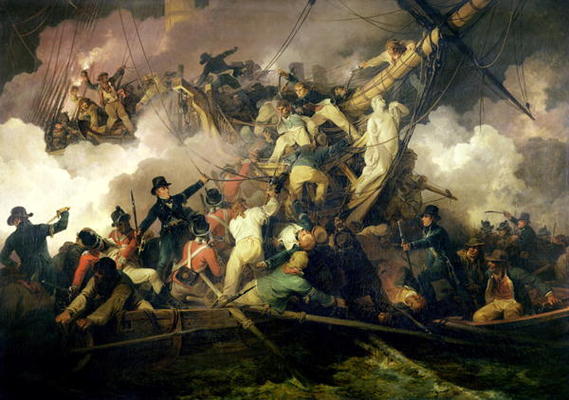
“The cutting-out of the Chevrette, 1801″
It is notable that in the case of the picture that first roused my interest in de Loutherbourg, “The Capture of the Chevrette”, the drama may seem extreme, yet the work was based on sketches made by officers who were actually present, and many of the faces are portraits of them. Given that his career had taken off under the Ancien Regime in France it is interesting to note that he was to live on to be fascinated by the very different world of the industrial revolution and to find it a challenging subject.
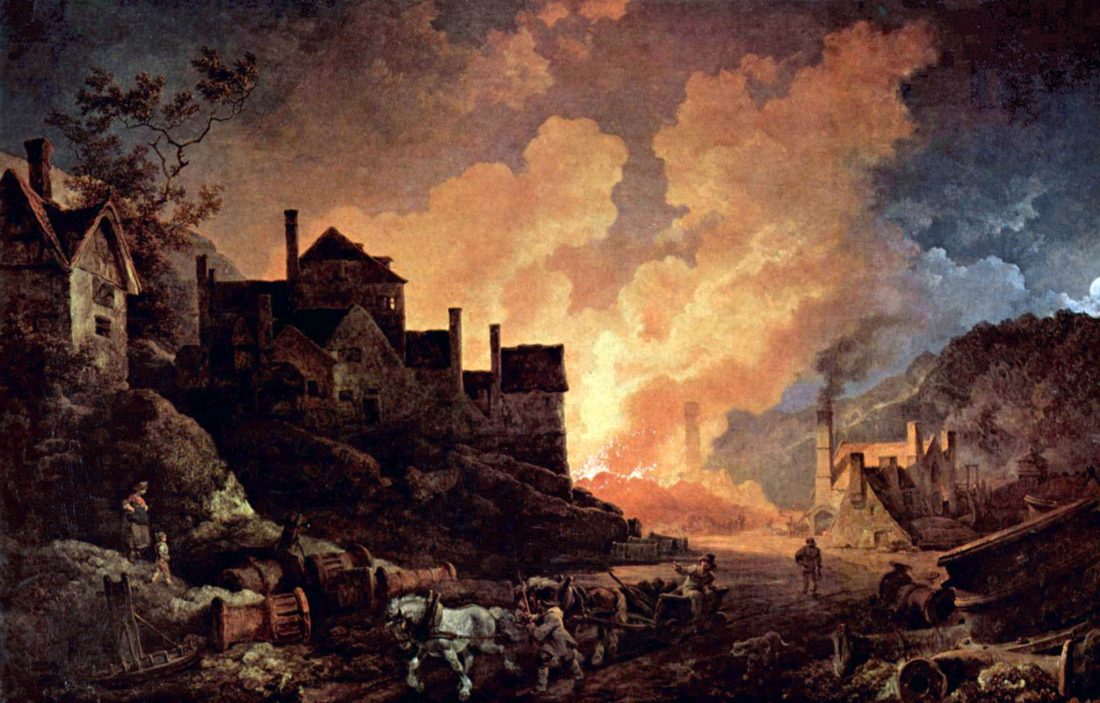
de Loutherbourg’s 1801 “Coalbrookdale by Night”: iron foundries in action
de Loutherbourg continued to be interested in the technology of spectacle and one could well image that had he been born a century and a half later he would have flourished as a movie-director in the Abel Gance mould. His most notable achievement in this area was his invention of the “Eidophusikon”(Image of Nature), a small mechanical theatre that used lighting, stained glass, mirrors and pulleys to achieve spectacular effects. Shows were given to audiences as large as 130 and the subject matter was – as could be expected – spectacular in the extreme. The most spectacular appears to have been the scene from Milton’s Paradise Lost in which Satan marshals his followers on the shored of a lake of fire and the rising of the Palace of Pandemonium. Impressive and popular as it was, the venture could not justify its costs and it had to close, leaving de Loutherbourg to return to more conventional work. One can well imagine how, today, he would have gloried in the possibilities offered by CGI.
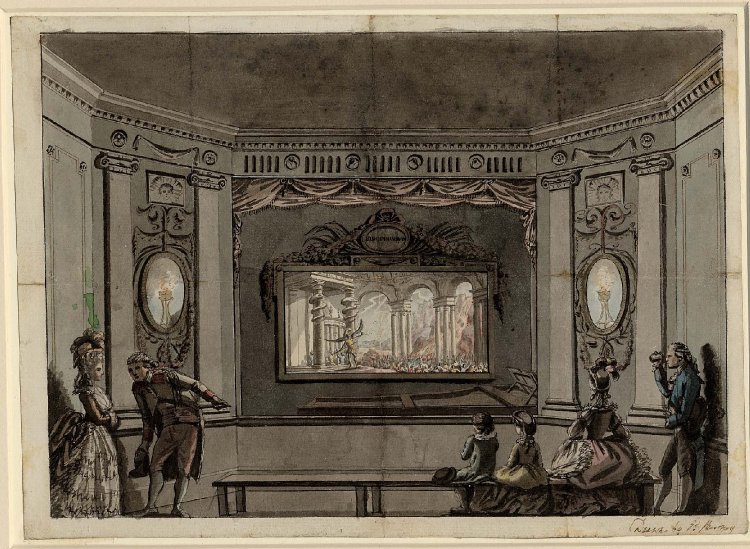
de Loutherbourg’s “Eidophusikon”
de Loutherbourg died in 1812 and though his career had been a very unusual one it was not the only one in which great maritime art was to emerge in this period from unlikely backgrounds. I’ll return in later blogs with some very surprising instances.
p.s. Two years ago I encountered one of his paintings, “The Hermit” in the Museum of Fine Arts in Houston, Texas
Start the Dawlish Chronicles series of naval adventures with the earliest chronologically:
Britannia’s Innocent
For more details regarding purchase in paperback or Kindle format, click below Note that Kindle Unlimited subscribers can read at no extra charge
The Dawlish Chronicles – now up to nine volumes, and counting, Click on the banner below for details. 
Six free short stories are available for download to your Kindle. Access them by registering for the Dawlish Chronicles mailing list – just click on the banner below. You’ll be kept updated on new books and will receive other free stories at intervals.



